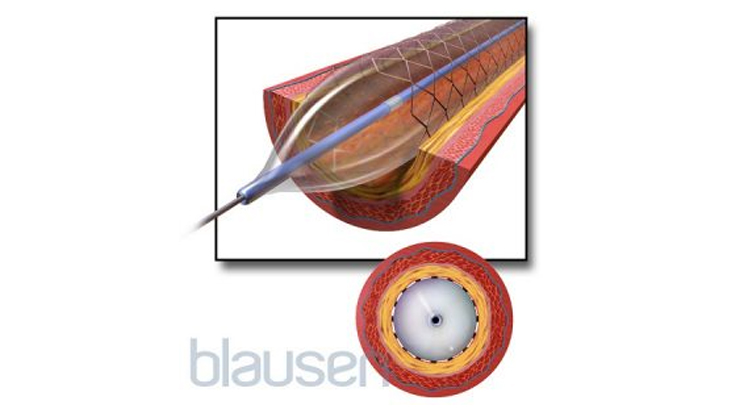A mesh tube used to treat narrow or weak arteries
Stenting often follows an angioplasty in which a doctor temporarily inserts and inflates a tiny balloon in a blood vessel to widen or unblock it. Your doctor may then recommend placing a stent, which can be placed permanently to further improve and maintain blood flow.

The doctors in our Interventional Cardiology Program and Vascular and Endovascular Program are experts in placing various types of stents, including:
-
Carotid artery stenting, which improves blood flow through the large blood vessels in your neck that supply blood to the brain.
-
Coronary artery stenting, which supports blood flow to the heart muscles.
-
Renal artery stenting, which improves blood flow through the arteries that supply blood to the kidneys.
-
Venous stenting, which supports blood flow through vessels affected by deep vein thrombosis or chronic venous insufficiency.
Conditions
Carotid Aneurysms
An extracranial carotid artery aneurysm is a bulge that weakens the walls of the main artery in your neck and may create blood clots that can result in a stroke.
Cervical (Carotid or Vertebral) Artery Dissection
Cervical artery dissection is a condition in which there is a tear in the wall of one of the four main arteries in the neck that supply blood to the brain.
Claudication
Claudication is muscle pain caused by clogged arteries that reduce blood flow to the muscles.
Coarctation of the Aorta
Coarctation of the aorta is a narrowing of the aorta, the body’s largest artery that carries blood from the heart to the rest of the body.
Coronary Artery Disease
Coronary artery disease is the most common type of heart disease in the US.
Fibromuscular Dysplasia (FMD)
A disease that causes abnormal cell development in the artery wall and results in arteries that bulge, tear, or narrow.
Kawasaki Disease
Kawasaki disease is a rare condition that causes inflammation of the blood vessels and can result in heart disease.
Left Renal Vein Compression (Nutcracker Syndrome)
Left renal vein compression, also known as nutcracker syndrome, occurs when the vein that that carries blood filtered by the left kidney is pinched between the abdominal aorta and another artery or the spine.
Leg Aneurysms
A leg aneurysm is a bulge in a blood vessel that can cause blood clots or reduced blood flow.
Renal Artery Disease
Renal artery disease, also known as renal artery stenosis, is a narrowing or blockage of the renal arteries, which bring blood to the kidneys.
Spontaneous Coronary Artery Dissection (SCAD)
Spontaneous coronary artery dissection is a tear in the layers of tissue of the coronary artery. Blood can collect between these layers, causing a blockage of blood flow to the heart.
Venous Occlusion
A condition in which a vein becomes narrowed, blocked, or compressed by nearby structures, such as muscles, arteries, or other veins.
Venous Thrombosis
Venous thrombosis occurs when a blood clot forms in your veins.
Tests
Angiogram (Angiography)
An angiogram is a special x-ray taken as a special dye is injected through a thin, flexible tube called a catheter to detect blockages or aneurysms in blood vessels.
Cardiac Catheterization
Cardiac catheterization is a minimally invasive way to diagnose and treat a variety of heart and vascular conditions by guiding thin, flexible tubes called catheters through blood vessels to problem areas.
Computerized Tomography (CT) Scan
The cardiac computed tomography scan, or cardiac CT, uses x-rays to create three-dimensional images of your heart and blood vessels.
Echocardiogram
An echocardiogram uses high-frequency sound waves to create images of your heart.
Electrocardiogram (ECG)
An electrocardiogram, also known as an ECG, measures the heart’s electrical activity.
Fluoroscopy
A fluoroscopy is an imaging technique that uses a continuous x-ray beam passed through the body to create real-time, moving images of your internal structures.
Fractional Flow Reserve
Fractional flow reserve, also known as FFR, is a measurement of how well blood can flow through the coronary arteries. Narrowing or blockages in these arteries can lead to a heart attack without treatment.
Pulse Volume Recording
Pulse volume recording tests are used to evaluate blood flow through the arteries in your arms or legs.
Our providers
Expert cardiology care
Getting the care you need starts with seeing one of our cardiologists.
Our locations
Distance from Change locationEnter your location
MedStar Good Samaritan Hospital
5601 Loch Raven Blvd. Baltimore, MD 21239
MedStar Southern Maryland Hospital Center
7503 Surratts Rd. Clinton, MD 20735
MedStar Union Memorial Hospital
201 E. University Pkwy. Baltimore, MD 21218
MedStar Franklin Square Medical Center
9000 Franklin Square Dr. Baltimore, MD 21237
MedStar Montgomery Medical Center
18101 Prince Philip Dr. Olney, MD 20832
MedStar Washington Hospital Center
110 Irving St. NW Washington, DC 20010
MedStar Georgetown University Hospital
3800 Reservoir Rd. NW Washington, DC, 20007
Additional information
Vascular and endovascular program
Partner with a recognized leader in offering care ranging from straightforward vascular disease to the most complex vascular disorders.
Ask MedStar Heart & Vascular Institute
Have general questions for our heart and vascular program? Email us at AskMHVI@medstar.net. If you have clinically-specific questions, please contact your physician’s office.









